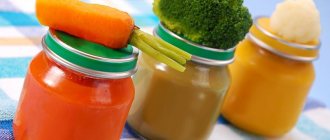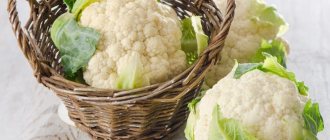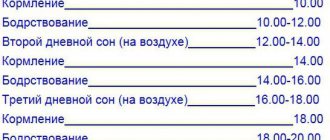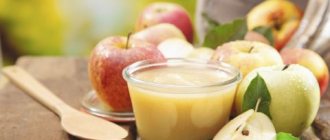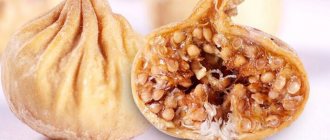Possible adverse reactions
Banana is a hypoallergenic fruit and rarely causes adverse reactions in the body. In case of individual intolerance or too rapid introduction to complementary foods, the following may occur:
- diarrhea;
- allergic rash;
- flatulence;
- nausea.
Adverse reactions may not be due to the fruit itself, but due to harmful fertilizers on the plantation and chemical treatment of already collected fruits to allow for long-term transportation. If you have unpleasant symptoms, you should give up the fruit for 2 weeks.
Then try to offer it to the child again and observe whether a full return to the diet is possible.
How to introduce it into the diet
Banana is a sweet fruit and it is not recommended to introduce it first into a child’s diet. It is better to start complementary feeding with vegetables, continue with cereals and unsweetened fruits. After that it's the banana's turn. This sequence is important so that the child does not give up other tastes in favor of sweets.
According to the rules of complementary feeding, no more than one new product is given in one day. You should not introduce unusual foods during illnesses, vaccinations and stressful situations. It is better to start with a small piece, offering the fruit in the first half of the day. This will allow you to more accurately track potential consequences for the body.
When should you give your baby a banana?
When can you give your child a banana, and at what age is complementary feeding allowed? Some doctors recommend complementary feeding from 6-7 months, but more cautious recommendations indicate the age of 8-9 months. Someone gives a banana to a child after a year.
To avoid any doubts about how many months to feed your baby bananas, consult your pediatrician.
Advice. Considering the ability of children to get used to “tasty” foods easily and quickly, it is not recommended to give bananas as the very first complementary food. The baby will refuse the yolk, pear or apple and wait for a portion of delicious sweet fruit.
Some mothers are surprised to listen to the advice “not to introduce bananas into the baby’s diet until six months,” because their child ate sweet puree perfectly from the age of five months, and the child did not have any rash on the child’s face. The answer is simple: in all children, the body is formed differently, and food digestion does not occur in the same way. You shouldn’t be surprised, but you shouldn’t risk giving complementary foods to a one-month-old baby either.
How to choose the right fruit
When purchasing, you should focus on the color and degree of ripeness of the fruit:
- Green fruits are unripe. They contain the least sugar and 87 kcal per 100 grams of weight. They contain a lot of tannin, which causes fermentation in the stomach. It is better not to give this fruit to small children to avoid flatulence and discomfort in the stomach.
- Bananas with dark spots are overripe. The most high-calorie fruits are high in glucose and fructose. Black spots on the skin may indicate mold damage. They should also be protected from the children's table.
- Yellow, evenly colored and ripe fruits. These bananas are moderately sweet and have an energy value of 95 kcal. They are considered suitable for a child.
We invite you to familiarize yourself with New varieties of medium-fruited cucumbers: advantages and disadvantages.
Fruits are not intended for storage in the refrigerator and packaging. Bananas should be left in a cool and dark place. Storing close to other fruits, especially apples, can speed up the ripening process of green fruits.
From what month can you give your baby banana and banana puree?
When the child reaches the age of one and a half years, complementary foods begin to be introduced to him. The baby’s further development and health depend on proper complementary feeding. Fruits are at the top of the list of foods recommended as complementary foods.
Among them you can find banana. Banana is usually added to complementary foods because it is one of the most nutritious fruits with beneficial properties. This fruit is easily digestible and almost does not cause allergies, which makes it a suitable complementary food for infants. However, there is no clear answer to the question of when to offer your baby a banana.
pros
Banana has a beneficial composition.
- It contains many vitamins B and C, which help normalize a child's sleep and protect his nervous system. This fruit also contains vitamins E, PP and K, which are necessary for the proper development of the baby.
- Bananas contain many micronutrients, such as potassium, sodium, magnesium, fluoride and iron. A child needs potassium to maintain the functioning of the heart, and other microelements are needed for the formation of various systems in the baby’s body.
- Thanks to starch, digestion is normalized. It is also broken down into glucose, which gives the baby energy.
- Due to the softness of the banana, it is easily digestible, so the fruit is suitable for consumption even by small children.
Banana Effects
Such complementary foods, like any other, will affect the baby’s stool. With the help of pectin, which is contained in this fruit, many harmful substances are removed from the body. Thanks to this feature, banana can normalize stool and digestion.
The formula for losing weight is simple - burn more calories than you take into your body. The mistake of all those who lose weight! Girls, just lose weight, here’s the recipe: before breakfast... Read more...
Typically, green fruits are used as a laxative that can relieve constipation. However, green bananas should not be given to infants, as their high starch content may cause allergies.
About the start time of complementary feeding
At what age can you offer a banana to a baby? There is no clear limit on how many months a child should be given this product. Doctors usually recommend introducing fruit into complementary foods from 7 months. Many parents decide to give bananas earlier - from 4 months, before vegetables, but the result is that then the child does not want to eat unsweetened vegetables, but prefers only bananas. It is also worth considering that until the age of six months, the baby’s digestive system will have difficulty coping with such food.
If the baby is overweight, doctors recommend abandoning the idea of giving the infant bananas, no matter how many months he is. Due to the large amount of sucrose in this fruit, the benefits for overweight children are questionable. Also in this case, a banana will be inappropriate, since it may cause an allergy.
If the baby is underweight, you will also have to wait a while with the banana, and the first complementary foods will need to be based on cereals. In this case, you should also not rely on the baby’s number of months, since a banana in complementary foods can only harm him. In such situations, giving fruit is allowed only when the baby reaches a normal weight.
How to offer
Complementary feeding should be given to the baby gradually and in small portions, when his body is ready to digest new food. During the first days, you can offer banana only with 1/5 teaspoon. For young children, this fruit must first be mashed to a puree consistency - something they can swallow.
It is allowed to give an infant special baby purees sold in stores. This type of food not only has the right consistency, but also contains additional vitamins and minerals that the child needs for development. However, sometimes, due to such nutrition, the baby may have skin allergies, since a certain cooking recipe is sometimes not suitable.
There is also a recipe for making puree at home. You should take 1 ripe banana of even yellow color, wash and peel it. Any strips that remain after skinning must be removed. There are several ways to make banana puree.
- Cut pieces of fruit can be wrapped in gauze and gently squeezed through the cloth. This results in banana puree that has a soft consistency. The gauze must first be ironed with a hot iron to eliminate the presence of microbes on the fabric. This recipe requires little time, and the result is well accepted by the children's digestive system, since the puree has a liquid consistency. This food can be offered to a baby from 6 months.
- You can grind the banana in a blender or grate it. This recipe is the simplest and does not require much time. When the resulting banana puree is thick, you can pour a small amount of mother's milk into it.
- When parents decide to give their child fermented milk products, banana can be mixed with them. To prepare such a cocktail, it is recommended to use a special recipe: to the norm of a fermented milk drink, you should add the norm of complementary feeding of a banana, corresponding to the development of the baby. If your child drinks such a drink, monitor the reaction on the skin to avoid allergies. Many parents are interested in how many months to offer their child this drink. It is recommended to give the cocktail to him from 12 months.
As the baby begins to get used to the new product and does not develop an allergy, you can gradually increase the dosage of the fruit.
When teeth appear, it is useful to give him a banana with a coarser consistency, replacing the puree recipe with finely chopped fruit. This form of complementary feeding should be tried from 9 months. The ideal time for complementary feeding is the morning, as there will be time to observe the baby's reaction. If the baby has an allergy, complementary feeding must be stopped immediately. And only after a month can another attempt be made to provide this fruit.
grudnichky.ru
Is it possible to eat a banana if you have diarrhea?
Due to the large amount of starch, fresh banana has a strengthening effect on the intestines. If a child has a tendency to loose stools that is not associated with illness, eating a small amount of fruit can help correct the situation. You need to choose only ripe yellow fruits.
In case of diarrhea due to rotavirus infection or poisoning, banana should be excluded from the diet. A fruit that is difficult to digest will increase the load on the gastrointestinal tract. A weakened stomach is unlikely to be able to digest it, which can lead to increased diarrhea.
Once symptoms are relieved, banana can be administered to speed up the body's recovery and maintain hydration. It will accelerate the growth of intestinal flora and help the healing of the mucous membrane.
Limitations and frequency of use
High nutritional value and rich composition allow you to give your child a banana every day in moderation. A good solution would be to replace cookies and candies with sweet desserts with banana or give it fresh. For babies under one year old, the daily portion should not exceed half a fruit.
There are a number of cases when it is better to reduce the consumption of soft fruits. High calorie content and large amounts of sugar can negatively affect children who are prone to or have the following diseases:
- diabetes;
- increased blood glucose levels;
- overweight.
For other diseases, it is recommended to completely eliminate bananas from the menu:
- heart disease;
- thyroid diseases;
- epilepsy;
- pathologies of the skeletal system.
It is also not recommended to give your child a banana before the main meal. Natural sweetness can negatively affect your appetite.
Helpful cooking tips
Thanks to their viscous pulp, bananas will help out the housewife in the absence of many ingredients. You should only use fruit crushed into puree and when preparing sweet dishes. You can try replacing the following ingredients in the recipe:
- eggs for ½ banana;
- part butter for an equal amount of puree;
- some sugar when baking pies and brownies.
We invite you to familiarize yourself with Royal Pelargoniums, angels and uniques || Pelargonium angel randy
If the skin of the fruit has turned black, it is used only for preparing dishes that require heat treatment. High temperatures kill the fungus that has infected the fruit, and high sweetness comes in handy in baking.
At what age should bananas be introduced into complementary foods?
Pediatricians believe that ripe sweet bananas are generally not suitable for the first complementary feeding of children in their first year of life for several reasons:
- the taste of sweetness interrupts the baby’s desire to try and consume other products;
- The sucrose present in bananas aggressively affects the baby’s intestinal mucosa, causing bloating and colic.
As a result, the first banana feeding should take place no earlier than 6-8 months, regardless of the type of feeding the baby has received up to this point. After all, some parents claim that they started feeding their children banana puree from the age of four months. It is possible, but by this time the digestive tract has not yet been fully formed, so the baby will not be able to digest coarse fiber.
In addition, such fruit can be excluded from the diet provided:
- fixation of excess weight in a child;
- development of allergies (although this occurs in rare cases);
- problems with stool (either disorder or constipation occurs);
- establishing hereditary diabetes mellitus;
- increased blood clotting factor.
How to give banana to baby
Having weighed all the pros and cons of taking this delicacy, let’s move directly to the scheme for consuming the overseas “guest”.
At what age can you give your child a whole banana?
The transition to whole fruits is recommended for 10-12 months of life.
Important! Bananas take a long time to digest, so they are not given before bed.
They begin to introduce the fruit into complementary foods with half a banana, cut into small pieces. As it approaches one year of age, the dose is increased to a whole specimen, treated in the same way. If the baby has already developed teeth, you can switch to whole fruits.
Banana complementary food
A separate topic is the use of complementary foods. This is where children begin to become acquainted with these fruits.
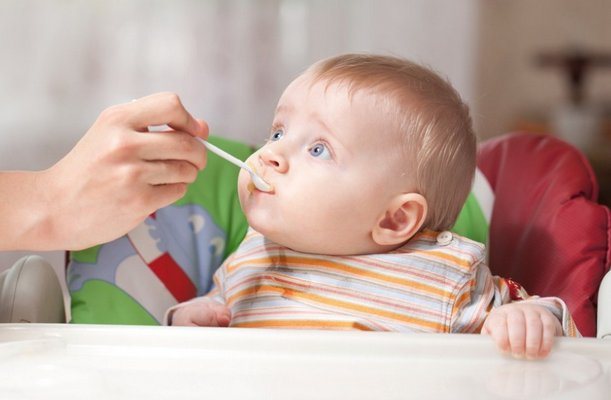
How to give a banana to a child
During complementary feeding, only purees are used - at first there should be no whole fruits. Please note that by this point the baby should already be accustomed to food in the form of vegetable purees from grated carrots, potatoes or zucchini. This is a must.
Find out more about what is normal weight gain for a child, how his height increases month by month, how to teach him to sit, crawl, roll over, walk independently, talk, blow his nose and count.
The fact is that after a sweet banana dish, a child may simply refuse regular food (and this should not be allowed).
How much to give
The safest scheme is the following:
- at 6-7 months, give from 0.5 teaspoon to 3 tablespoons of liquid puree per day. The volume is increased slowly, monitoring how the body accepts the new product;
- 8-9 months: thicker puree is allowed (from 3 tablespoons - up to half of the processed fruit);
- Babies 10-12 months old are given pieces, and then whole fruits (from half to whole).
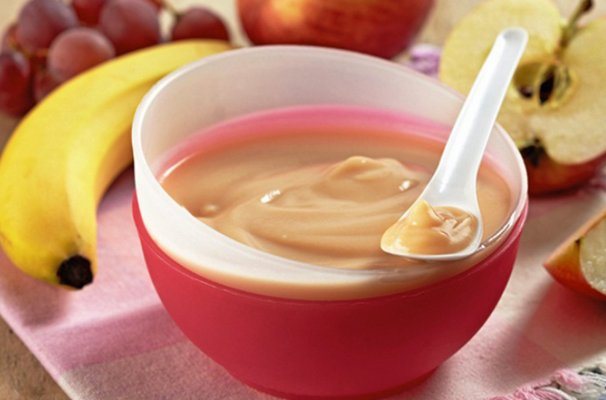
Did you know? Banana is the record holder among fruits for the content of vitamin B6 (it contributes to the production of the “happy” hormone (serotonin).
The indicated amounts are often adjusted in practice. It happens that the child liked the treat, and if the stomach accepted it without problems, the dose can be increased slightly. And vice versa, if the baby is not very willing to take it, you should not feed him the whole preparation at once.
At what age and in what form can it be given?
Each family individually decides at what time to introduce complementary foods. Main landmarks: the emergence of food interest and the extinction of the instinct to push food out with the tongue. But you shouldn’t rush into complementary feeding and start earlier than 5-6 months.
It is also advisable to wait until the first tooth appears and the child is able to sit independently. It is better to give bananas from 7 months and not in the evening. The fruit takes a long time to digest by the stomach and can prevent the baby from falling asleep.
The first banana feeding is given heat-treated and mixed until smooth with breast milk or formula for better absorption. You can prepare it as follows:
- Remove peel and long fibers.
- Cut into small circles and steam.
- Add a small amount of mother's milk or adapted formula.
- Beat with a blender until smooth.
There is no need to do heat treatment and homogenization every time the baby wants a banana.
2-3 times are enough for the child’s stomach to get used to the new food and begin producing the appropriate enzyme. The amount of the first serving should not exceed half a teaspoon.
At the beginning of complementary feeding, you can give banana in the form of puree or from a special device for complementary feeding - a nibbler. The soft fruit allows you to chop it even with a fork, and in a nibbler it will be convenient for an infant to try to chew it with his gums. Up to 9 months, it is better not to give more than 3 tablespoons of puree at one meal.
We invite you to familiarize yourself with the Conductive Bundle of Pumpkin
To start complementary feeding, puree can be mixed with already familiar fruits and vegetables. Kids will love the combination with a sour apple, pear or pumpkin. If you want to purchase ready-made puree, you should pay attention to the following:
- the composition does not contain sugar or preservatives;
- appropriate age labeling;
- When opening the jar there is a popping sound.
Once opened, the puree can be stored in the refrigerator for 24 hours. For children under one year old, it is better to buy small jars: the first portions are extremely small, and most of the puree will remain uneaten. When choosing, you should pay special attention to the manufacturer and expiration date.
When the baby has mastered the crushed fruit, it is worth moving on to eating it whole. It is recommended to give a banana to a child closer to 9-10 months. It is better to start with half and under the supervision of parents.
A one-year-old baby can easily eat a whole fruit.
From what month can a baby be given a banana?
When starting to introduce complementary foods, many mothers are puzzled by the question of how many months can a baby start giving a banana. Almost all children love it, because it has a sweet taste and delicate texture. In addition, it contains a huge amount of vitamins and elements necessary for the development and construction of systems of a growing body. But this fruit raises some concerns among parents due to its exotic origin, which is why they often worry about how many months a baby can start eating bananas.
Before answering this question, let's remember what is useful and necessary for a person in a banana. This yellow-skinned fruit contains sucrose, which contributes to its high calorie content. Therefore, a banana is a snack product during periods of increased mental or physical stress.
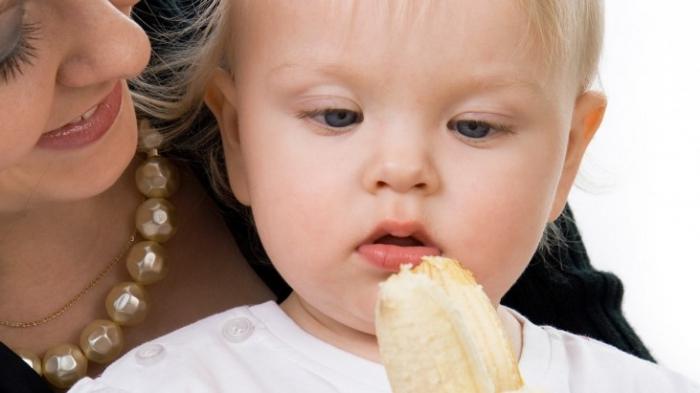
As for babies, it is convenient to give a banana, for example, on the road or on a walk when the baby is hungry. It also contains a high content of vitamin B, which takes part in the formation and functioning of the baby’s nervous system. The next useful vitamin for a child’s body is C, which is slightly less in a banana than in citrus fruits. It is necessary for the formation and maintenance of immunity. Potassium, fluorine, iron, magnesium and sodium are necessary for the full functioning of the cardiovascular system, bone and muscle tissue.
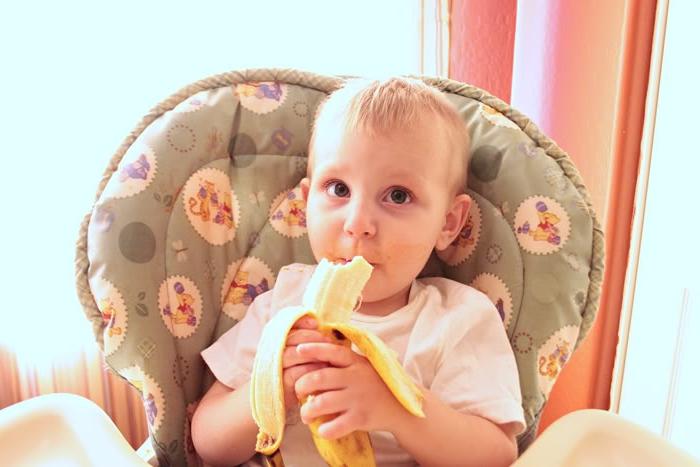
The starch contained in a banana breaks down in the body into glucose, which acts as a source of energy necessary for life. Like other fruits and vegetables, bananas contain fiber, which is responsible for the normal functioning of the intestines and maintaining the necessary microflora in it. In addition, banana is considered a hypoallergenic product, and its moderate consumption is not associated with disorders in the gastrointestinal tract.
From how many months can you give banana?
Despite the beneficial properties of banana, many parents are in no hurry to introduce it into complementary foods. Most of them begin to do this after a year, when the baby’s digestive system is already more stable and can process different foods. In addition, the fact that the banana does not grow in our latitudes, which means it is foreign to our digestive tract, is also a concern. When moms and dads think about how many months to start giving bananas, they should first consult with their pediatrician.

Doctors recommend that a normally developing child be given bananas from 6-8 months. You should start with half a teaspoon of mashed banana puree, gradually increasing the portion if the baby accepts this product well. You need to pay attention to the child’s stool, whether he has any allergic rashes, gas, colic, etc. Despite the fact that bananas are hypoallergenic, they can, like any other product, cause a reaction in the body due to its individual characteristics.
From how many months can you give a banana if you want to provide your baby with varied and nutritious nutrition? The decision remains with the parents, but this can be safely done after six months of age. If you have doubts about the way bananas are processed (there is a version that they ripen in special gas chambers), then it is better to buy ready-made baby purees in jars. You need to consult with doctors about how many months you can give a banana to your baby. After all, they, like parents, are responsible for their recommendations.
Composition and benefits of bananas
The fruit contains minerals necessary for the body, trace elements important for the functioning of the body, and amino acids necessary to maintain a good mood. Banana is rich in iron, biotin, manganese, copper and pantothenic acid. It contains a large amount of fiber, which has a positive effect on intestinal motility.
Banana contains the highest amounts of the following nutrients:
- silicon - 30 mg;
- potassium - 348 mg;
- magnesium - 27 mg;
- vitamin K - 348 mg;
- vitamin B6 - 0.38 mg;
- vitamin C - 10 mg.
The fruit will help make your baby calmer and reduce irritability. Regular consumption helps strengthen bones, increase hemoglobin levels, normalize heart function, improve the functioning of the gastrointestinal tract and strengthen the general condition of the body.
A banana has 21 grams of carbohydrates, 19 of which are sugars and 2 are starches, 1.5 grams of protein, 0.5 grams of fat and 74 grams of water. This composition saturates the child well and makes banana a convenient snack.
When is the best time to introduce banana?
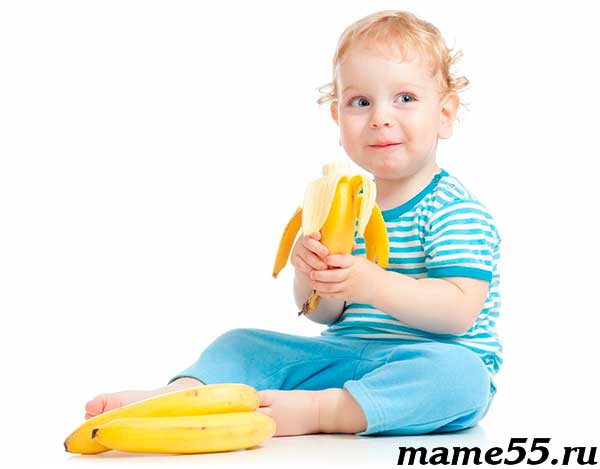
Experts recommend that infants begin introducing bananas no earlier than six months. After the first complementary foods in the form of vegetables and cereals, there is an introduction to fruits. This occurs no earlier than 8-9 months and is considered normal. Of course, not all mothers adhere to such rules, and some are in a hurry to dilute their baby’s monotonous diet with such a tasty delicacy. The main thing is not to start your first complementary feeding with this exotic product. Let the baby adapt better and try fresher and less tasty food first. After all, after a sweet fruit, it is very difficult to fall in love with tasteless and monotonous zucchini or cauliflower.
Earlier introduction of bananas into the diet can cause colic and even poisoning. Since this fruit is quite filling, in order to avoid stress on the gastrointestinal tract, you should not eat it at night. The best time to consume it is lunch and afternoon tea. When to give a banana, of course, is up to the parents to decide, but pediatricians are inclined to conclude that it is best to do this no earlier than 7 months, and most importantly after the introduction of vegetables and cereals.
